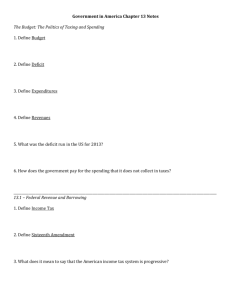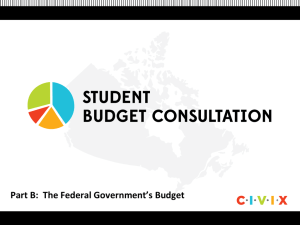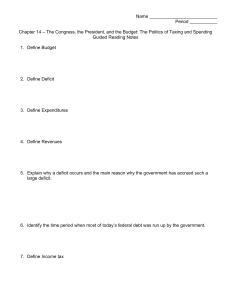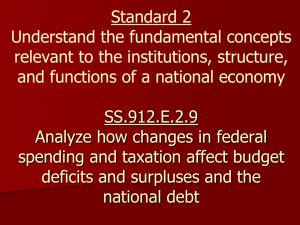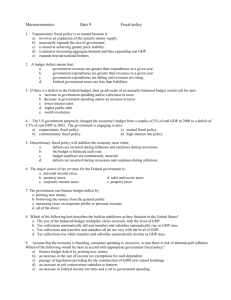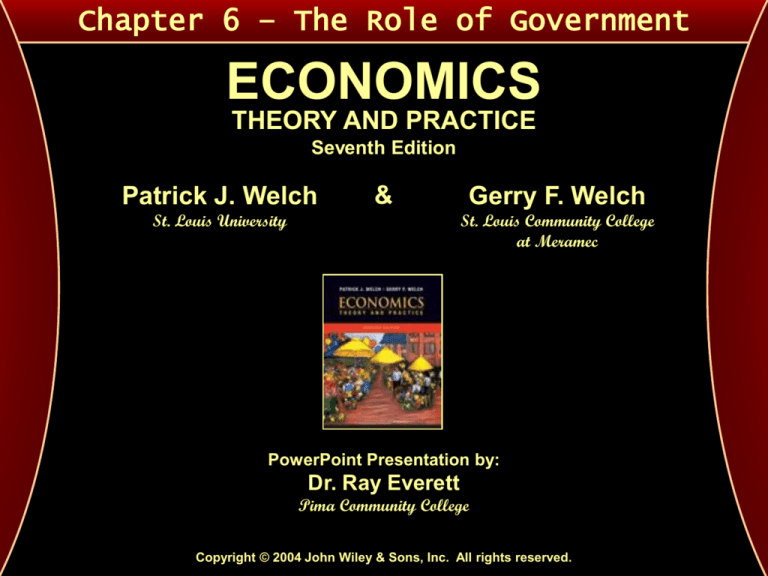
Chapter 6 – The Role of Government
ECONOMICS
THEORY AND PRACTICE
Seventh Edition
Patrick J. Welch
&
St. Louis University
Gerry F. Welch
St. Louis Community College
at Meramec
PowerPoint Presentation by:
Dr. Ray Everett
Pima Community College
Copyright © 2004 John Wiley & Sons, Inc. All rights reserved.
Role of Government in the Macroeconomy
Contents
Expenditures & Revenues
Fiscal Policy
Government Budgets
National Debt
Role of Government in the Macroeconomy
Chapter Objectives
• To identify the major types of expenditures and the major sources of
revenue of the federal, state, and local governments.
• To distinguish among progressive, proportional, and regressive taxes.
• To discuss recent tax issues and reforms.
• To introduce fiscal policy, explain its mechanics, and differentiate
between discretionary and automatic fiscal policy.
• To define a surplus, balanced, and deficit budget, and identify the
economic impact of each.
• To explain the relationship between the federal budget and fiscal
policy.
• To discuss some realities of fiscal policy and the budgetary process
that can hamper the attainment of fiscal policy objectives.
• To define the national debt, explain its financing, size, and burden on
taxpayers, and introduce crowding out.
Government Expenditures & Revenues
• Government Expenditures Overview
TABLE 6-2
Total, Federal, and State and Local Government Expenditures, and
Total Government Expenditures as a Percentage of GDP, Selected
Years 1979-2000 (Billions of Dollars)
6-1a
Government Expenditures & Revenues
• Categories of Government Expenditures
Government purchases of goods & services
• Government spending on new goods and services.
• Public Good
– Good or service provided for all of society.
• Quasi-Public Good
– Government-provided good that could be sold in a private
market.
Transfer Payments
• Money from the government for which no direct work is
required in return.
Interest paid on borrowed funds
Grants-in-aid to state and local governments
6-1b
Government Expenditures & Revenues
• Categories of Government Expenditures (cont.)
6-1c
Government Expenditures & Revenues
• Government Revenues Overview
6-1d
Government Expenditures & Revenues
• Government Revenues Overview (cont.)
6-1e
Government Expenditures & Revenues
• Sources of Government Revenue
Social Insurance Program
• Contributions from an individual’s wages are made to a
fund from which that individual may draw when eligible for
benefits.
6-1f
Government Expenditures & Revenues
• Progressive, Proportional, & Regressive Taxes
Progressive Tax
• Tax reflecting a direct relationship between the percentage
of income taxed and the size of the income.
– As income increases, so too does the rate at which that
income is taxed, and vice versa.
Proportional Tax
• Also called a flat tax.
• Tax equal to the same percentage of income regardless of
the size of the income.
– As income increases or decreases, the rate at which that
income is taxed remains constant.
Regressive Tax
• Tax reflecting an inverse relationship between the
percentage of income taxes and the size of the income.
– As income increases, the rate at which that income is
taxed decreases, and vice versa.
6-1g
Government Expenditures & Revenues
• Tax Reform & Issues
Tax Reform
• Changes in tax policies and structures.
Tax Bracket Indexation
• Policy of adjusting income tax brackets to account for
inflation.
Tax Reform Act of 1986
• Major legislation that changed federal income tax
exemptions, deductions, brackets, and rates.
Tax Base
• Particular thing on which a tax is levied.
Tax Rate
• The amount that is levied on the base.
Tax Abatement
• Policy of reducing or eliminating a tax that would normally
be charged.
6-1h
Fiscal Policy
• Fiscal Policy
Influencing the levels of aggregate output and
employment or prices through changes in federal
government purchases, transfer payments, and/or taxes.
• Mechanics of Fiscal Policy (Examples)
Unemployment due to a decline in spending can be
resolved by any or all of the following:
• Increasing government purchases of goods and services
• Increasing transfer payments
• Decreasing taxes
Demand-pull inflation from too much spending can be
resolved by any or all of the following:
• Decreasing government purchases of good and services
• Decreasing transfer payments
• Increasing taxes
6-2a
Fiscal Policy
• Types of Fiscal Policies
Discretionary Fiscal Policy
• Deliberate changes in government expenditures and/or
taxes to control unemployment or demand-pull inflation.
Automatic Fiscal Policy
• Also called automatic stabilization.
• Changes in government expenditures and/or taxes that
occur automatically as the level of economic activity
changes.
– Helps to control unemployment or demand-pull inflation.
6-2b
Fiscal Policy
6-2c
• Types of Fiscal Policies (cont.)
TABLE 6-5
Fiscal Policy Summary
Government Budgets
• Types of Budgets
Balanced Budget
• Government’s total expenditures equal its total revenues.
Surplus Budget
• Government’s revenues are greater than its expenditures.
Deficit Budget
• Government’s expenditures are greater than its revenues.
6-3a
Government Budgets
• Types of Budgets (cont.)
TABLE 6-6
Federal Budget Receipts, Outlays, and Surpluses or
Deficits for Fiscal Years 1940–2002 (Billions of Dollars)
6-3b
Government Budgets
• Types of Budgets (cont.)
TABLE 6-6
(continued)
6-3c
Government Budgets
• Beyond the Budget Figures
Unified Budget
• Budget that assembles all federal government receipts and
outlays, and the resulting overall deficit or surplus, in one
report.
Trust Fund
• Restricted fund.
– Payments from this fund are specified as to recipients
and/or uses.
Entitlement
• Programs set up by the government to pay benefits to
people who meet the eligibility requirements of the
programs.
On-Budget/Off-Budget
• Categories of the unified budget established by Congress.
– Generally refers to programs that have immediately
controllable and noncontrollable receipts and expenses.
6-3d
Government Budgets
• Beyond the Budget Figures (cont.)
TABLE 6-7
Federal Government Unified, On-Budget, and
Off-Budget Balances, 1990–2002 (Billions of Dollars)
6-3e
Government Budgets
• Budget & Fiscal Policy Summary
Surplus Budget
• Dampens aggregate spending and can aid in managing
demand-pull inflation.
Deficit Budget
• Increases aggregate spending and can help to reverse a
recession.
Balanced Budget
• Can slightly expand the economy.
6-3f
National Debt
• National Debt Overview
Accumulated total debt of the federal government due to
deficit spending.
6-4a
National Debt
• National Debt Overview (cont.)
6-4b
National Debt
• Financing the National Debt
U.S. Treasury Security
• Issued by the federal government in return for funds lent to
it.
– Largest portion of the national debt is held by private
investors, and the rest is owned by the Federal Reserve
Banks, government agencies, and trusts.
• Assessing the National Debt
Debt Service
• Cost of maintaining a debt.
– Generally measured in interest costs.
Crowding Out
• Occurs when borrowing by the federal government reduces
borrowing by households and businesses.
6-4c
National Debt
• Assessing the National Debt (cont.)
FIGURE 6-2
National Debt as a Percentage of GDP, 1970–2000
6-4d
Chapter 6 – The Role of Government
This is the end of Chapter 6.
To return to the contents menu of this
chapter, click on the menu graphic to the
right of this text.
To begin Chapter 7, click on the next
chapter icon to the right of this text.
Menu
Next
Chapter
ECONOMICS
THEORY AND PRACTICE
Seventh Edition
Copyright © 2004 John Wiley & Sons, Inc. All rights reserved. Reproduction or translation of this work
beyond that permitted in Section 117 of the 1976 United States Copyright Act without the expressed
written permission of the copyright owner is unlawful. Request for further information should be
addressed to the Permissions Department, John Wiley & Sons, Inc. The purchaser may make back-up
copies for his/her own use only and not for distribution or resale. The Publisher assumes no
responsibility for errors, omissions, or damages, caused by the use of these programs or from the use
of the information contained herein.


